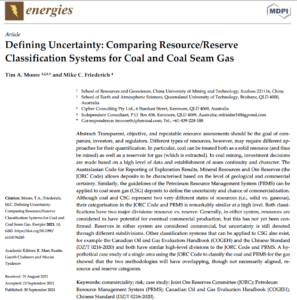The beautiful thing about data is its uncertainty. That is, in a world where sometimes it is hard to know what is real and what is…well, lets say not real, with data you can actually characterize how certain you are about such and such.
After a couple of decades of working in coal seam gas and almost as long in trying to estimate its in ground volume, my colleague Mike Friederich and I have published an Open Access paper* discussing different systems of classification for resources and reserves.
Over the years one of the gaps I’ve noticed is that coal-mining people are perhaps not as familiar as they’d like to be with how to estimate the gas in their coal but equally petroleum engineers and geologists have little understanding of how the tonnage of coal in the ground is determined. Thus, this paper sets out to explain in a relatively simple manner how both are done and where there are overlaps and differences.
We primarily review the JORC Code (for coal) and the Petroleum Resource Management System (PRMS) (for gas) but also touch on the impressive Canadian Oil and Gas Evaluation Handbook (COGEH) as well as the Chinese Standard (DZ/T 0216-2020). There are other classification systems, of course, but we choose these as they are the ones that are most accepted by financial and regulatory organisations because they address both risk and commerciality.
So, go get the paper! – its Open Access and thus no cost to readers (publication costs were kindly provided by Cipher Consulting); you can find it here: https://www.mdpi.com/1996-1073/14/19/6245 . If that link doesn’t work for some reason, just ask me for a copy.
We would like to thank the Guest Editors, Prof R. Marc Bustin and Dr Gareth Chambers for inviting us to submit to their special volume “Characterization of Unconventional Petroleum Reservoirs” (https://www.mdpi.com/journal/energies/special_issues/characterisation_unconventional_petroleum_reservoirs).
Finally, we are hugely appreciative of our reviewers: John Hattner (NSAI, Houston, USA), Prof Yong Qin (China University of Mining and Technology, Xuzhou, China) and David Green (GEMS, Brisbane, Australia). Their valuable inputs into the manuscript resulted in the paper being much improved.
So, much like James Bond himself, we can now go and have that martini. Though we have little care if it is shaken or stirred we are fairly certain it will taste fantastic!
*Moore, T.A., Friederich, M.C., 2021. Defining uncertainty: Comparing resource/reserve classification systems for coal and coal seam gas. Energies 14, 6245, 35 pp., https://www.mdpi.com/1996-1073/14/19/6245.




Comments are closed.